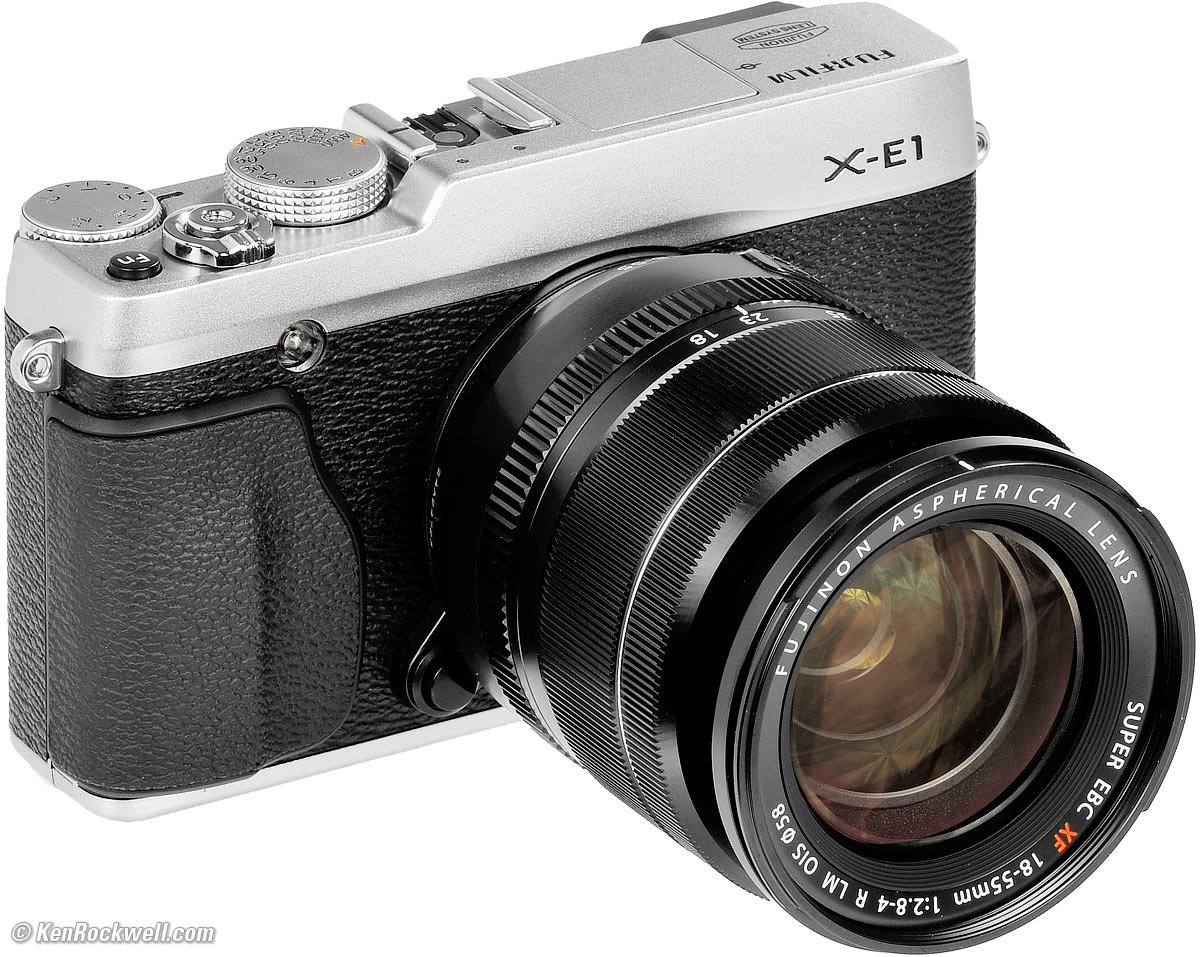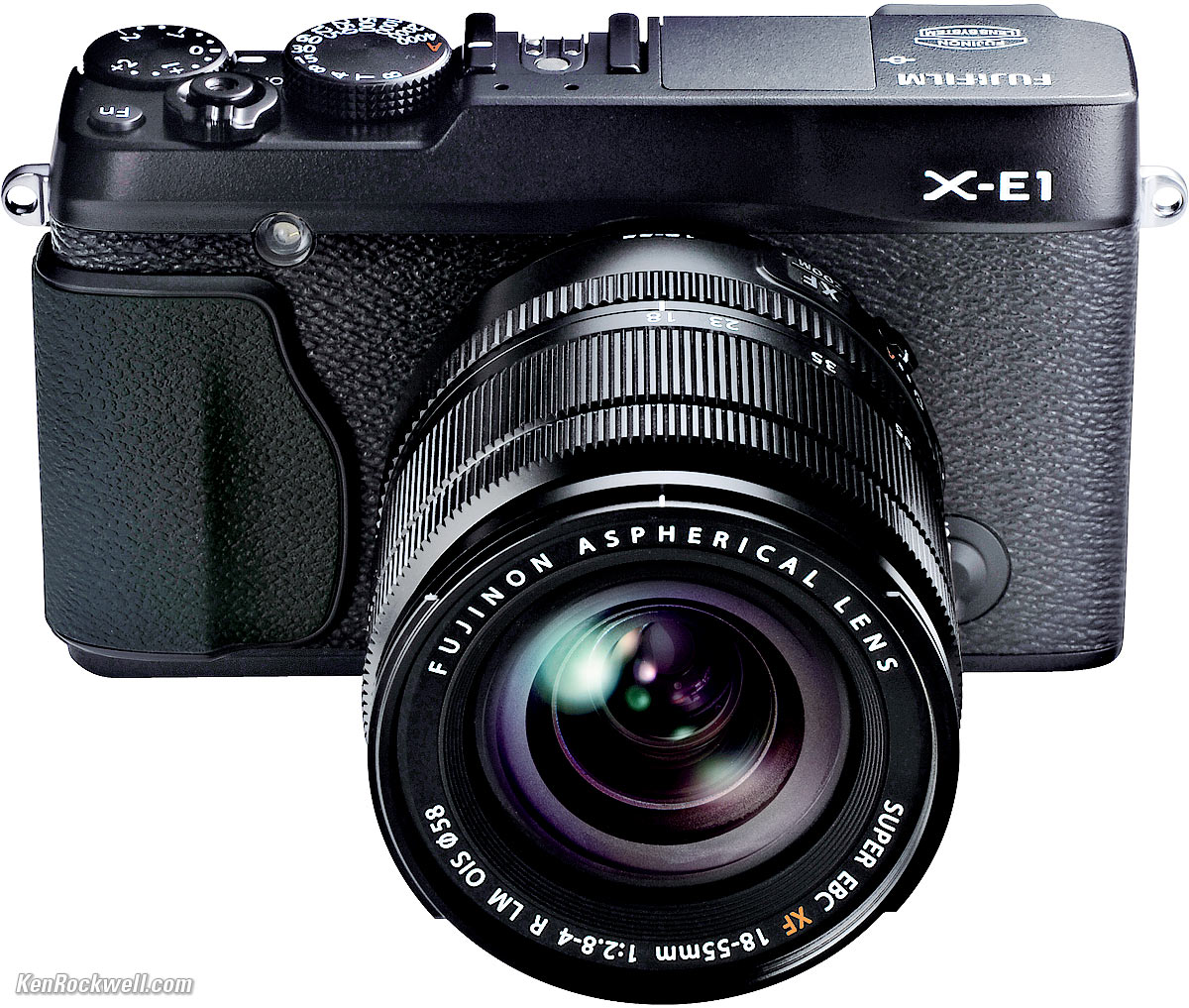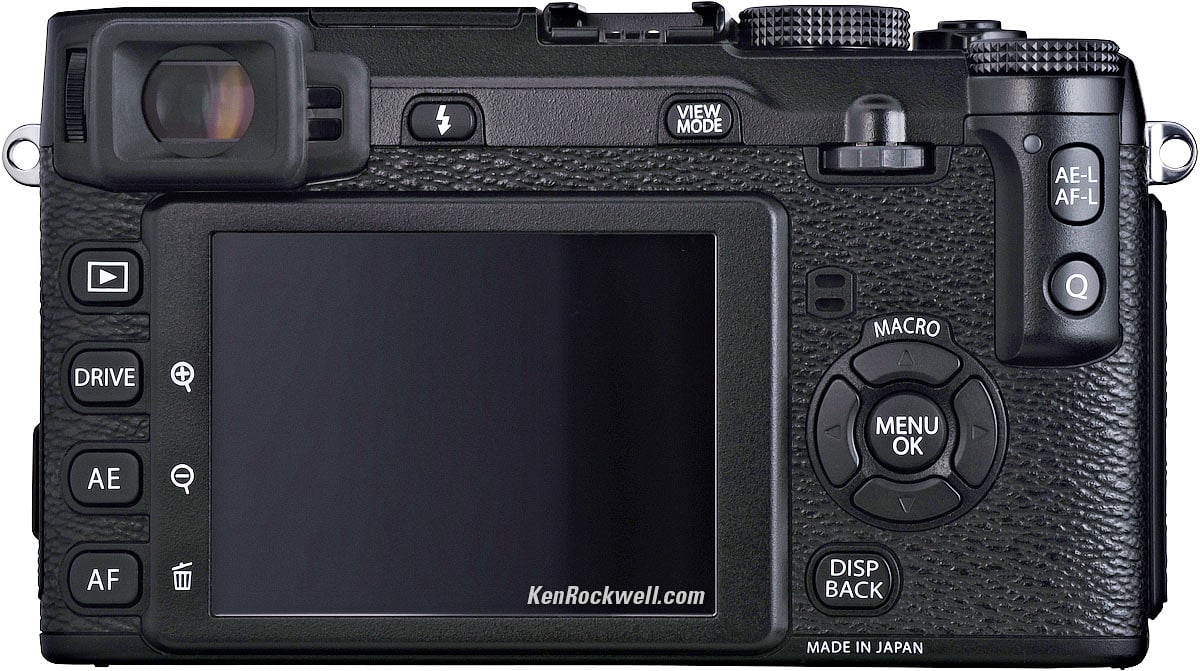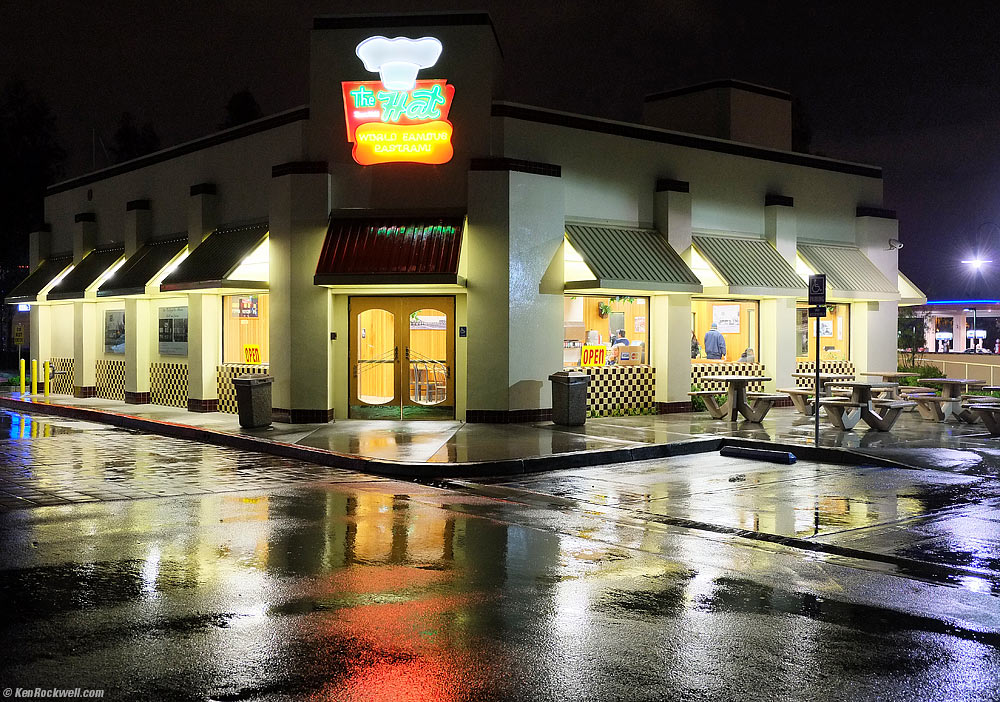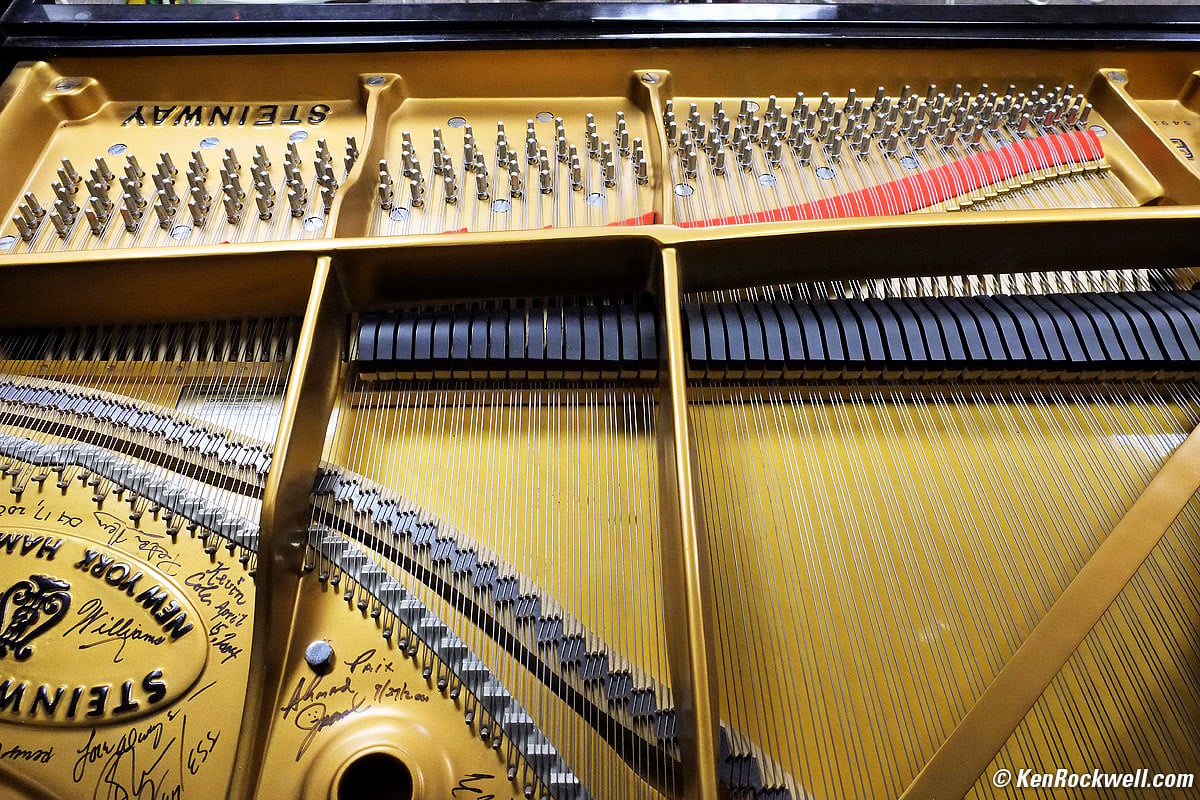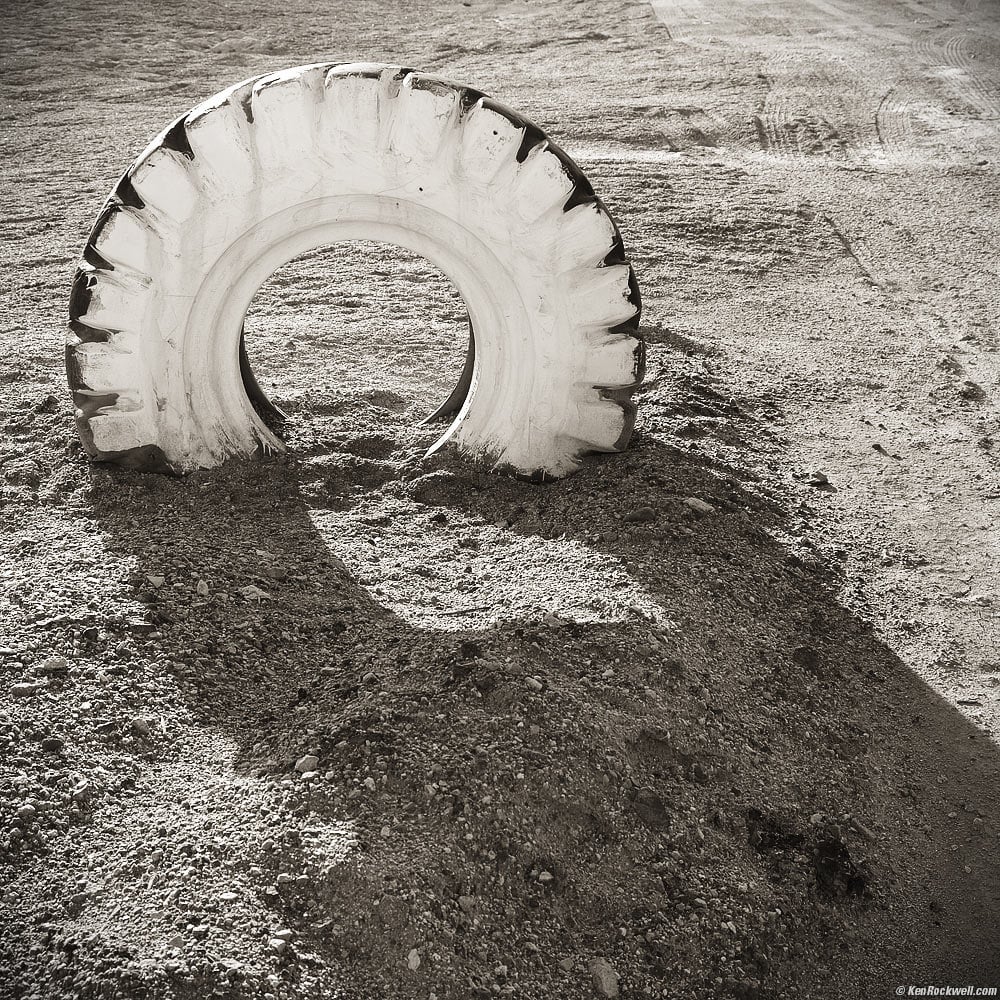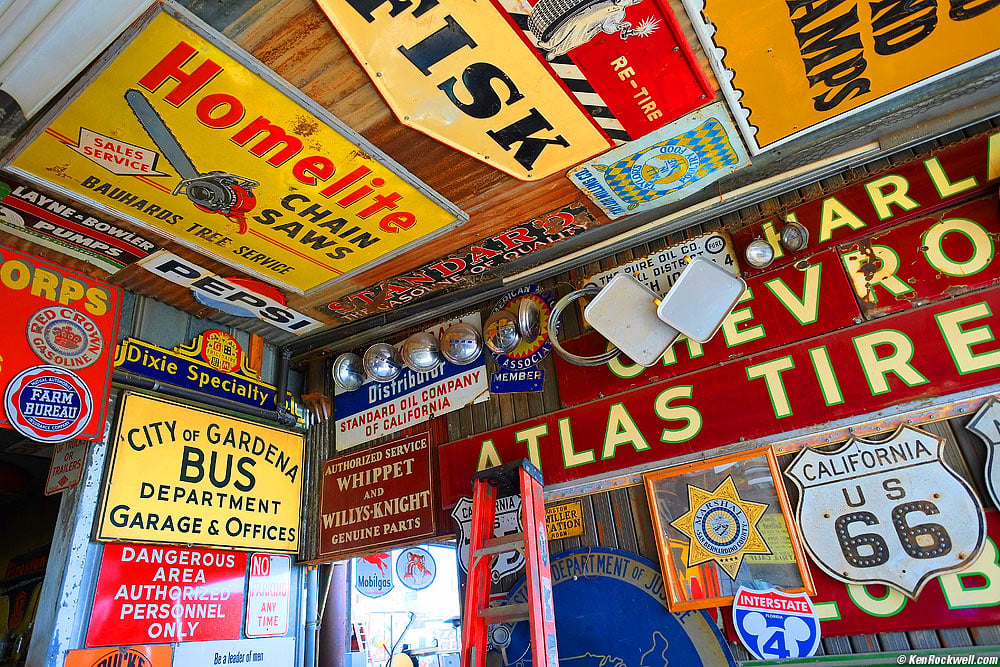Home Donate New Search Gallery Reviews How-To Books Links Workshops About Contact
Fuji X-E1 "Sexy One"
16MP, 1.5x sensor, OLED finder
Intro Specs Performance Compared Usage Recommendations More
Fujifilm X-E1 (12.4 oz./350g with battery and card, about $150 used if you know How to Win at eBay) and XF 18-55mm f/2.8-4 OIS. bigger.
This free website's biggest source of support is when you use thos or any of these links when you get anything, regardless of the country in which you live. Thanks for helping me help you! Ken.
May 2019 Better Pictures Fuji Fuji Lenses Sony LEICA Zeiss Nikon Canon All Reviews
Fujifilm X-E1 in black. enlarge.
Back, Fujifilm X-E1. enlarge.
Top, Fujifilm X-E1. enlarge.
The Hat in The Rain, 19 February 2013. (Fuji X-E1, Fuji 18-55mm at 24.3mm, AUTO ISO 1,600, f/3.2 at 1/30 hand-held, Perfectly Clear.) Original © file.
Commemorative Steinway; Ahmad Jamal et. al., 15 February 2013. (X-E1 at ISO 4,000, XF 18-55mm f/2.8-4 OIS at 18mm, f/8 at 1/30 hand-held.) bigger, full-resolution or camera-original © file.
Salt Boom, Amboy, 18 February 2013. (Fuji X-E1, Fuji 14mm f/2.8, AUTO ISO 200, f/7.1 at 1/350, Perfectly Clear.) Original © file.
Sample Image Gallery: Route 66, February 2013.
Fantastic ergonomics optimized for people who know how to shoot; a perfect shooter's camera with the right knobs in the right places.
Exceptionally sharp and undistorted images, due to no anti-alias filter on the sensor and super-sharp lenses, just like LEICA.
Extremely well built by today's standards. Unlike most of the disposable plastic (but expensive) cameras I review today, the X-E1 is a real camera: all-metal with engraved markings, and so are its lenses. It's better built than anything today from Nikon or Canon, and the same as LEICA — for a fraction of the price of any of them.
Extraordinarily good auto white balance in crummy light, as good as iPhone 5 and much better than DSLRs.
Great highlight rendition; the Auto Dynamic Range feature really helps hold the highlights regardless of the conditions.
Bad
Blah color rendition, much duller than Canon, Nikon or iPhone 5. It's optimized and great for people photos, but too dull for photos of things. The X-E1 excels in crappy light, but its colors don't look very good in good light. Even when set to HIGH color, it is subdued and doesn't respond well to adding saturation later.
Built-in flash exposure is only fair. It's nowhere near as good as the X100's flash.
Introduction top
Intro Specs Performance Compared Usage Recommendations More
The Fujifilm X-E1 (called the "Sexy One" in Japan) is an extraordinary camera as I've outlined above. It's faster and easier to use for people who know how to shoot because it has all the right controls in the right places, and it's always super-sharp and handles any crazy light you can throw at it. X-E1's color rendition is great for people photos, but a poor choice for color work of places and things. The X-E1 excels for black-and-white shooting because of its extraordinary sharpness and freedom from distortion, and I love shooting in its optional square format just like my Mamiya 6 or Hasselblad.
The X-E1 has a very different sensor from everything else that comes out of the Orient, and its images look very different. It has no anti-alias filter, so the results are much sharper than from most other cameras, and color rendition is strongly optimized for people, not thing, photos.
The X-E1 just shoots, and the results are always super-sharp and well exposed — better than I get from DSLRs, whose exposure and focus aren't always dead-on as they are with the X-E1. With the X-E1, it seems as if I can't make a blurry or malexposed shot.
The X-E1 is built as well and is as sharp as the legendary $7,000 LEICA M9 — but the X-E1 has better color rendition and is much cleaner at high ISOs!
The almost all-metal X-E1 is better-built than a Nikon D4, and with the X-E1's dedicated aperture, shutter speed and exposure compensation dials, handles much faster than today's DSLRs.
The X-E1 has a wonderful OLED finder, which also doubles for through-the-finder menu setting and playback.
The Fuji X-Pro1 has the same image sensor and XF lens mount. The X-E1 is 30% smaller than the X-Pro1, and has an even higher-resolution electronic viewfinder, for less money. The X-E1 has no optical finder as does the X-Pro1, but adds a built-in flash, all for less money.
I love the X-Pro1, and now the X-E1 does what the X-Pro1 does, with a better finder in a smaller package with the same battery, but more rated shots per charge, and a built-in flash! Bravo!
Far better than the defective fixed diopter of the X-Pro1, the X-E1 has a properly adjustable finder diopter.
The X-E1 has image quality and lenses more like my LEICA M9 than any DSLR, and it's smaller and lighter than any DSLR — or LEICA. The X-E1 does what the LEICA M9 does well, even better than the M9 does it!
The X-E1 has a 1.5x half-frame (DX) 1.5:1 aspect-ratio sensor and interchangeable lenses.
The X-E1 is lighter and quieter than the LEICA M9. The X-E1 allows you to shoot faster, be more discrete and attract less attention. The X-E1 brings back stunning technical quality from a compact, precise, all-metal camera with a minimum of fuss. When you learn it, the X-E1 is simpler and faster to shoot than the M9. Hallelujah!
The X-E1 is far better made than Fuji's previous plastic professional medium format cameras, and the Fuji lenses are as good as the Zeiss lenses for the Contax G2 and LEICA's lenses.
The X-E1 is made as well or better than the LEICA M9. The all-metal X-E1's markings are engraved more deeply and the buttons work and feel much better. The X-E1's tripod socket, not that you'd ever use it, is part of the camera body, not just an afterthought attached to the removable thin metal bottom plate of the M9. Of course there is through-the-lens viewing, completely absent on any LEICA available as I write this.
Shooting in JPG, the X-E1's colors far better than the LEICA M9, and images are far sharper as well. (The M9 makes lousy JPGs, but Aperture 3 can't read X-E1 RAF raw files. Read in Aperture, M9 DNGs can look a bit better than X-E1 JPGs.)
Fuji's optics are superior, offering SUMMICRON image quality with SUMMILUX speed, something even LEICA can't do.
Real shooters shoot LEICAs because of their simplicity, small size and fantastic optics, and the X-E1 does all this even better. The X-E1 is ergonomically superior to LEICA, the optics are at least as good, for a fraction of the price.
The X-E1 is what you get when you take the image and lens quality of the LEICA M9, put it in the ergonomically superior Contax G2, and then add a built-in flash. The X-E1 is also worlds better at high ISOs than the LEICA M9.
The Fuji X-E1 is a real camera, made of metal, not plastic, for photographers.
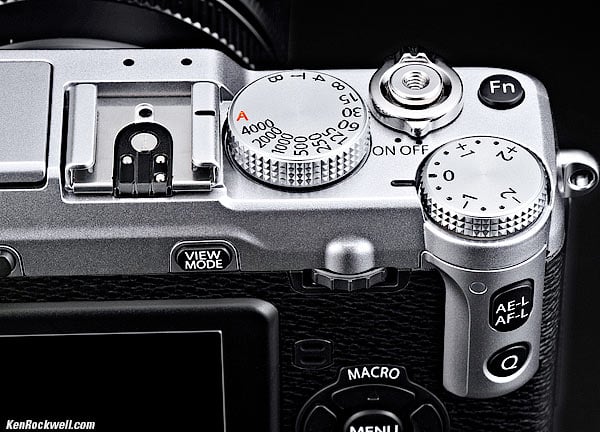
Fujifilm X-E1.
The X-E1 has shutter and aperture dials. Nikon and Canon don't any more.
The X-E1 has a real exposure compensation dial. LEICA and Nikon don't any more.
The X-E1 has real exposure mode switches. Nikon and Canon don't any more. Better yet, the Fuji, just like Contax, changes its exposure mode by turning the shutter and/or aperture rings to A when you want them to set themselves. Set both to A for Professional (formerly Program) exposure mode. Done.
The X-E1 makes movies too. The X-E1 has a built-in manual focus assist loupe.
Fuji has made cameras for Hasselblad, and sold under the Hasselblad name, like the X-Pan. Neither Nikon nor Canon has ever been good enough.
Like the M9, the X-E1's files will need some computer tweaking for stunning results for nature and landscape shots. Nikon and Canon's nature and landscape shots offer wild colors that still look natural, while pushing the Fujis and LEICAs start to look artificial.
It drives me nuts shooting a DSLR or M9 when I can't see my image pop up instantly in the finder after I've shot it — as I do with my X-E1. Yes, there are plenty of plastic consumer Micro 4/3 cameras with LCD finders, but they are not professional grade. Photographers don't do menus; forget the Sony NEX-7 and its flimsy plastic brethren that feel more cell phones than cameras, with their overpriced plastic zoom lenses and slow fixed lenses. I need a camera with real dials like the X-E1 and fast metal lenses, not a plastic toy.
Missing top
There's no RGB histogram, but the X-E1's fantastic highlight rendition means you don't need to watch for clipping individually in each channel as you do on other cameras. I don't use this on other cameras, but the X-E1's blinking highlight option works just fine instead.
There's usually no Program shift available most ways that you can set the camera, but that's not a problem, since all you need to do is flick the aperture or shutter dial instead.
No PC (Prontor-Compur) flash sync terminal; use an adapter from the hot shoe.
Lens Compatibility top
As of February 2013, the only available X-mount lenses are:
XF 14mm f/2.8 XF 18mm f/2 XF 35mm f/1.4 XF 60mm f/2.4 Macro
Luckily, I've tested all these, and each is excellent.
The X-E1 can use LEICA and other brands of lenses cave-manually with a Lens Adapter, but don't use anything other than the Fuji XF lenses in the range from 18-60mm.
When used with random lenses on an adapter, the XE1 has manually-set controls to correct distortion, color edge shading and falloff correction. Each corner's color shift set can be set individually for use with lenses like the 12mm Voigtländer.
Specifications top
Intro Specs Performance Compared Usage Recommendations More
Lens Mount
Stainless-steel Fuji X-Mount.
Flange focal distance: 17.7mm.
Electronic aperture.
Electronic focus.
Sensor
Unique non-Bayer color array that eliminates the need for an anti-alias filter and yields much sharper images compared to other camera, but can limit what software can open the RAF raw files.
23.6 mm x 15.6 mm DX.
1.5:1 aspect ratio.
16 MP.
4,896 x 3,264 pixels native.
Ultrasonic cleaner.
Image Sizes
Automatic internally-stitched panorama: L (16.6 MP): 7,680 x 2,160 and M (7 MP) 5,120 x 1,440.
L: (3:2, 16 MP) 4,896 x 3,264, (16:9) 4,896 x 2,760, (1:1) 3,264 x 3,264.
M: (3:2, 8 MP) 3,456 x 2,304, (16:9) 3,456 x 1,944, (1:1) 2,304 x 2,304.
S: (3:2, 4 MP) 2,496 x 1,664, (16:9) 2,496 x 1,408, (1:1) 1,664 x 1,664.
I love the square crop!
Glowing Tire of Hope, Amboy, 18 February 2013. (Fuji X-E1, Fuji 18-55mm at 1" (25.4mm) focal length, AUTO ISO 200, f/5.6 at 1/210, Perfectly Clear, edge-burned and split-toned print.) bigger.
Not only do I love shooting in the square, square icons grow to be much larger than rectangular icons in most image sorting and Finder applications.
ISO
ISO 200 ~ ISO 6,400.
Pull mode to ISO 100, push to ISO 12,800 and ISO 25,600.
AUTO ISO 200 ~ 6,400.
AUTO ISO sets the slowest shutter speed at 1/(equivalent focal length), or 1/50 second with the normal 35mm f/1.4 lens.
Dynamic Range Options
100%, 200%, 400%, or AUTO (100%-400%).
Finders
No Optical viewfinder.
Electronic viewfinder
0.5"
2,360,000-dot color OLED. (X-Pro1 is only a 1,440,000-dot color LCD.)
25º apparent angle.
100% coverage.
Eye sensor.
23 mm eye point.
Video
1,920 x 1,080 @ 24p.
1,280 x 720 @ 24p.
Maximum take length: 29 minutes.
Autofocus
TTL off-the-sensor autofocus for zero AF error.
One AF area at a time, but you can move that area all over the frame.
Light Meter
TTL.
256-zone matrix, spot or average.
Flash
Built-in flash: GN 5 meters, 16 feet, at ISO 100. (7 meters, 22 feet, at ISO 200).
Dedicated hot shoe.
Rated for up to 300V sync voltage.
No PC sync terminal.
Rated 1/180 sync, but I never saw the camera shoot above 1/140 with flash in daylight.
Shutter
Metal focal-plane.
It supposedly allows multiple exposures; I never tried.
6 FPS (fast) and 3 FPS (slow), but no AF or exposure changes.
1/4,000 ~ 1/4 second in PROGRAM and Aperture-Priority modes.
To 30 seconds in Manual mode.
To one hour in Bulb mode.
Maximum speed with flash (sync): Rated 1/180, but I never saw the camera shoot above 1/140 with flash in daylight.
Remote: Any standard screw-in cable release.
Movies
1080/24p or 720/24p.
29 minute maximum length.
Uses the same film simulation, color and B&W modes as the still camera.
Audio
Stereo mic.
2.5mm stereo mic input.
File Formats
Photos
JPEG
RAF raw.
RAF+JPEG
Video
.MOV files.
Storage
SD, SDHC or SDXC (UHS-1) slot.
Data Communication
USB 2.0.
HDMI mini connector.
Rear LCD
2.8" LCD.
460,000 dots.
100% coverage.
Power
Battery
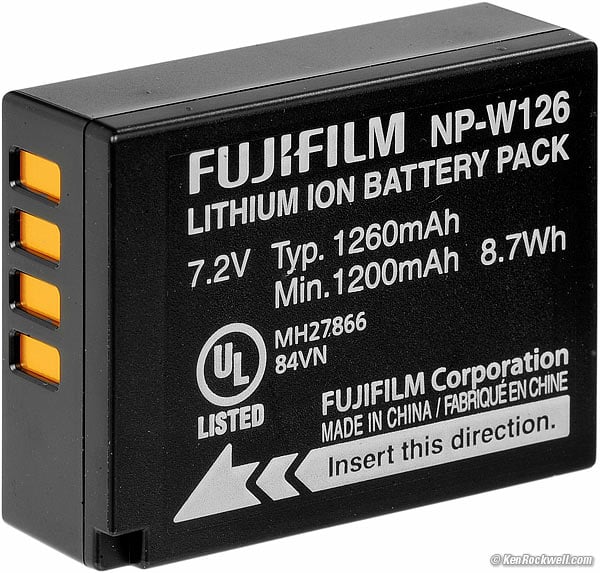
Fuji NP W128 Battery.
NP-W126 Li-Ion battery (same as X-Pro1 and X-T1).
Rated about 350 shots.
Charger
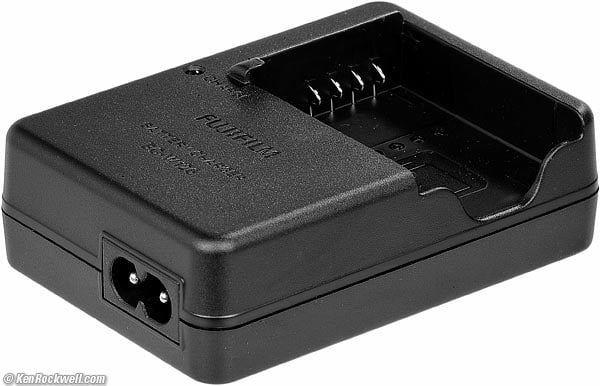
Fuji BC-W126 Charger.
BC-W126 (same as X-Pro1 and X-T1).
Corded, uses common "∞" shaped plug end.
100~240V, 50-60 Hz.
Made in China by JET.
Rated 13~21 VA input, 8.4VDC 0.6A output.
Quality
Made in Japan.
Die-cast magnesium top and bottom covers.
Environmental
32 ~ 104°F (0 ~ 40°C).
10 ~ 80% RH, no condensation.
Size
5.1 x 2.9 x 1.5 inches WHD.
129 x 74.9 x 38.3 millimeters WHD.
(Minimum depth: 30.9 mm/ 1.2 in.)
(X-Pro1 is 5.5 x 3.2 x 1.7 inches WHD, 139.5 x 81.8 x 42.5 millimeters WHD, Minimum depth: 1.3 inches (34.1 mm).)
Weight
12.365 oz. (350.5g) with battery and card.
Fuji rates it as 12.35 oz. (350g) with battery and card, and 10.6 oz. (300g) stripped naked.
(The X-Pro1 weighs 15.672 oz. (444.3g) with battery and card.)
Colors
Black or silver.
Includes
Fujifilm X-E1 Digital Camera Body.
Li-Ion Battery NP-W126.
Battery Charger BC-W126.
Shoulder Strap.
USB Cable.
Body Cap.
Metal Strap Clip.
Protective Cover.
Clip Attaching Tool.
CD-ROM (Viewer software, RAW File Converter etc.).
Owners Manual.
Fuji Warranty.
Optional Accessories
High quality leather half case
FUJINON XF Lenses (3 available and 2 announced today, 10 total by end of 2013)
LEICA M Mount Adapter
Ergonomically designed hand grip
Three dedicated flash models to choose from depending on requirements (EF20, EF40, EFX20)
Protector filters (39mm, 52mm, 58mm)
Remote release cable (RR-80)
Announced
06 September 2012.
Promised
November 2012.
Actually Shipped
December 2012.
Prices, USA top
Fall 2012 ~ March 2013X-E1 body only: $999.95.
X-E1 and 18-55mm kit: $1,399.95.
Performance top
Intro Specs Performance Compared Usage Recommendations More
Overall
As covered before, the E-X1 combines great handling and the exceptional construction quality of a real camera so rarely seen today with unusually sharp, well-exposed and in-focus images. The only bad part is that colors are great for people and for anything in poor light, but poor for most other things for which we want color images.
While the real dials allow instant input, overall electronic handing and processing speed is merely OK, and feels even a little slower than my X100. It's fast enough not to ge tin the way, but you're always aware that the X-E1 is just barely keeping up with the pro user.
Autofocus
Autofocus is fast enough for subjects that hold still, but not as fast as a DSLR for tracking action.
It's easy to move the AF sensor any place in the frame, far better than DSLRs which put all their AF sensors only in the middle of the frame.
Your chosen AF sensor position is saved and recalled with each focus mode. If you use the center sensor in AF-S, the left side in AF-C and the upper right in Manual, each will still be there when you switch back.
The AF-C (continuous) mode is still foolish. It doesn't continue to focus once you half-press the shutter, so ho cares?
The manual focus rings of the lenses I tried worked poorly, as expected. No worries, the proper way to use the manual focus mode is to tap the AFL button to spot-focus as needed; not to use the focus ring.
Tap the top rear dial and the AF area zooms instantly to check whatever manual focus area you've selected. Yes, its easy to focus manually on the top left of the frame if you wish.
Worse than DSLRs, the X-E1 isn't good enough to focus on most clouds in the sky, which most Canon DSLRs do amazingly well.
Sadly, to move the AF area around you have to hold the AF button with one hand at the same you use your other hand to tap the four directional buttons. This button is right under your eye, where your thumb will get in the way. If you don't hold down the AF button, three of the directional buttons are ignored, and the top one gets you in and out of the Macro mode. Ooops!
Good news is that there's a red AF! warning that pops over your finder if the X-E1 can't focus on something. This is good, because the X-E1 focuses so well most of the time that I forget that there is rarely something on which the X-E1 doesn't immediately grab focus.
I really like the X-E1's focus system. I get every shot in perfect focus, better than any other brand of camera in my experience. With other cameras I sometimes shoot bursts just in case, and with the X-E1, they're all always in perfect focus, so I have to train myself to trust the X-E1!
Macro
There is a Macro button, and paradoxically, it does absolutely nothing, at least with the XF 14mm f/2.8 and XF 18-55mm f/2.8-4 OIS with which I tested it.
Finder
Far better than the defectively designed fixed diopter of the X-Pro1, the X-E1 has a properly adjustable finder diopter control.
The X-E1's OLED electronic finder is bright, sharp and colorful, but on the small side. It's small, and not well aligned for two-eye shooting.
Images look great though it, in fact, too good. I think it exaggerates the colors, giving you a false sense of security. Images look vibrant on the brilliant, contrasty finder, but duller on a calibrated monitor.
The X-E1 has marvelous automatic eye-control, so the rear LCD or electronic finder come up automatically depending on how you're holding the camera. The only defect in the automatic eye-control is that if bright sunlight is shining on your eye as you hold it to the finder, that the X-E1 may switch back to the rear LCD instead. Another defect can be that when shutter is halfway down, the X-E1 won't swap between rear LCD and OLED finder as you move your eye.
The worst thing about the finder is that the exposure compensation scale cover the left part of the image, and never goes away (you can delete it in a Custom setting, but only on a second Custom screen option, not the Standard display). Adding insult, it doesn't change character if compensation is set or not, so even though it's always in the way of our composition, it doesn't do anything more to warn if it got knocked and is active. Fuji should make the scale go away at zero, and appear when set to other than zero.
If activated the focus-distance bar graph hides the bottom of your image.
The switchable level and grids are very helpful in getting level shots. In my 2013 Route 66 gallery, I never needed to level my shots later; they came right out of the camera level, saving me a lot of time. The level disappears beyond ±45° of vertical tilt.
Built-in Flash
The pop-up flash is cute, but feels as if it will break quickly.
Sadly, the slow sync speed (1/140 max in actual shooting) prevents the tiny flash from being useful in daylight for flash fill, and indoors, it usually overexposes. This is too bad; the Fuji X100 has a leaf shutter with a much higher (1/1,000 or more) sync speed and works great in all these conditions.
Oddly, I also felt a slight shutter delay when used with the built-in flash, and thought I may have had to wait for the flash to recycle on occasion.
It's too weak to be likely to be useful, but you can push and hold its springed cantilever a bit to bounce it vertically.
All in all, the built-in flash is a loser compared to the X100.
Shutter
The shutter is quieter than a DSLR, and noisier than the silent leaf of the X100.
There is just a tiny delay, presuming you've got everything locked with a half-press of the shutter. It's not instant as I'd prefer, possibly an instant slower than my X100.
I love having a real cable release socket. Oddly, screwing it in or removing it will rotate the concentric power power switch to ON or OFF!
Trigger pull is as expected, with the usual slight detents. There's some horizontal play in the button; this is no LEICA M3 (but it's still better than the big kinks in the pull of the LEICA M9).
Ergonomics
As I've covered, having real metal dials for everything puts this Fuji in LEICA territory, far above today's slop from Nikon, Canon and everyone else.
The grip feels swell in my hands. This tiny camera always feels stable.
The response to button presses isn't always instant.
The status LED is invisible on the right side of the camera away from the finder.
The LCD or finder counts down during long exposures, and counts up during Bulb exposures! This is great, but as you're waiting for the camera to time and "process" a dark-frame subtraction for noise reduction, there's no "processing" countdown on the finder. The eye-control won't swap displays if you move your eye during any of this.
The self timer sadly has to be found in a menu.
Menus are well paged, much better than on Nikons.
The SD card is difficult to reach at the corner of the bottom door hinge.
The exposure compensation knob still needs a deeper detent at zero, or a lock button.
The shutter-speed knob is too small and too far back, so it needs two fingers to set, unlike a LEICA.
It works even with the card and battery door open.
Image and Color
As covered above, the basics are always great, but I dislike the color rendition for anything other than people shots.
Tom's Welding. (Fuji X-E1, Fuji 14mm f/2.8, AUTO ISO 400, f/3.2 at 1/150, Perfectly Clear, boring colors further amplified in Photoshop CS6.) Original © file.
These colors look OK to the undemanding, but here's how it looked six years ago as shot on an original Canon 5D for comparison without needing all the tweaks I had to apply to this Fuji shot (see the Original © file for how it came from the X-E1; the Canon shot is relatively as it came from the camera). Yes, even today, the original Canon 5D is still an awesome performer, for a bargain price.
If you're photographing vivid colors, the X-E1 images look fine, but ordinary colors can't be made to pop! in-camera. Attempting to pop the colors later in software rarely works well.
If you want a different color balance, you may be able to get a vivid look in raw software, but honestly, if it's vivid colors you demand, shoot a different camera. The X-E1 excels for people and B&W photography, but for me, not for vivid images of nature and things.
Forget the "Velvia" mode; it's horrible. It doesn't look at all like Velvia; it looks like a bad scan of Velvia, with crushed blacks and shadows devoid of any detail.
The unique sensor design gives super-sharp JPGs as shot, but also means that your favorite software might be less likely to be able to open the X-E1's RAF raw files. Photoshop CS6 does just fine, as updated in February 2013.
Auto White Balance is usually superb, even in the nastiest of artificial light. In fact, under fluorescent or those bogus "energy saving" lights, the X-E1's images usually look better than the scene does to my naked eye!
High ISOs look great as shown at the samples above, cleaner than most other cameras with this sized sensor.
Metering and Exposure
Ahhh, it's almost always perfect, far better than DSLRs. The only way to fool it is shooting white paper filling the frame in indoor light, which comes out gray. No worries; it's trivial to flick the compensation dial.
Playback
You can swap images while zoomed, but diagonal scrolling doesn't work very well.
The zoom controls are right under your eyeball when you use the finder for playback. Worse, the PLAY button is also on the wrong side of the XE1, demanding a second hand to hit PLAY.
Sadly a zoomed image doesn't fill the screen; a black bar remains along the bottom.
You can zoom from the detailed info page. The image then fills most of the screen with blank bar at the bottom; you can't read sectional histograms as zoomed.
Advancing among images goes super-fast, but just like on Canon, it always takes a moment when an image is selected for it to redraw with full detail.
Data
SD cards don't format properly. They remain as "untitled," not "FUJI XE1" as they should.
Auto-set ISO reads correctly in Media Pro, my favorite sorting tool.
NORMAL LARGE JPGs are about 3MB.
LARGE NORMAL (square) JPGs are about 2 MB.
NORMAL MEDIUM JPGs are about 1.9 MB.
RAF raw files are 26.1 MB.
Video
I didn't try any video clips; I'm a photographic artist, not a vidiot.
I do like that the X-E1 has a built-in stereo microphone.
Power and Battery
The Sexy One is rated for 350 shots per charge, and that seems about right if you don't use much flash and do a lot of repetitive shooting.
When I work carefully and use the camera, but only fire the shots about which I'm actually serious, I only get about 225 shots per charge. The X-E1 sucks power any time you're viewing though it, regardless if you take a picture.
Compared top
Intro Specs Performance Compared Usage Recommendations More
NEW: 2014 Comparisons at my X-T1 Review.
See also my 2012 DSLR Comparison.
Versus the Fuji X-Pro1
Both use the same 16MP sensor, XF lens mount, slow shutter speed ranges and battery.
They are 99% the same thing, except that the X-E1 costs less, adds a built-in-flash, a much better finder, and loses the optical finder.
I don't own my X-Pro1 anymore, but by association, I think the X-Pro1 operates a little bit faster then the X-E1.
Versus Fuji X100
The Fuji X100 is the same thing as the X-E1, and adds a dual optical/electronic finder and fantastic fixed 23mm f/2 ASPH (35mm equiv.) lens.
The X100 handles a little faster, its flash performance is far superior, and it's smaller, lighter and much quieter.
The X100's 23mm f/2 ASPH has about the same autofocus speed, but much quieter operation, than the interchangeable X-mount lenses.
Personally, since the X100 is smaller than any of the X-E1 or X-Pro1, I prefer the X100 over the more complex interchangeable-lens cameras.
Most of you reading this love to carry too much equipment, but since the fixed lens of the X100 is the only lens I need, personally, I prefer the X100.
Usage top
Intro Specs Performance Compared Usage Recommendations More
Focus
To move a focus point, hold the AF button and press the four rear directional buttons.
To change the AF spot size, hold AF and rotate the rear dial.
Push the top rear dial to zoom on the focus point.
Forget the focus ring in manual focus. Instead, tap the AEL/AFL button for spot manual focus in manual focus mode.
Exposure
You can't set the Auto ISO slow shutter speed, but you can flick the shutter dial to the speed you want in Auto ISO and the X-E1 will take it from there.
Shift the exposure program with the rear left-fight control buttons — except that it won't shift in Auto ISO or Auto Dynamic Range and other modes! See page 33 of the US manual for more.
Exposure always seems to lock with the shutter halfway down, and I couldn't unset that.
The effects of exposure compensation aren't apparent while shooting in the A mode in dark conditions (you will of course se e it in your final images).
You can get depth-of-field preview if you set the Fn button to do it.
To set 1/3 stop manual speeds: press the rear left-fight control buttons.
"B" is the usual Bulb mode, but "T" isn't Time mode. T really ought to be marked "LT," for Long Time. Use the T setting and the rear left-fight control buttons to set exposure times between 1/2 and 30 seconds. Use Bulb for times up to an hour.
Once set, the time you selected in T is recalled each time you select it, until power off resets it back to 1/2.
If set to bulb in A mode, gives 30s.
P goes to 1/4s, A mode goes to to 30s.
Bulb counts up, in the finder or rear LCD, to 60 minutes.
If you're in the middle of a long exposure in the Auto or timed manual modes, turning off the camera won't stop it — the X-E1 will dutifully keep on with its long exposure until it's done!
Settings
I prefer to set JPG NORMAL, not HIGH.
I set Color +2 High, which is still pretty tame.
I set AUTO ISO 6,400; even at ISO 6,400 if needed, the X-E1 looks fine.
I set Auto Dynamic Range (AUTO DR). Set this way, the X-E1 increases ISO as needed (to ISO 800 even in daylight) to retain highlight detail, all automatically as needed. it's a huge benefit; be sure to turn it on to AUTO.
I set my Fn button to image size. This is how I select rectangular or square images from shot to shot.
Panoramas and Self Timer
Panorama and self timer are in the drive mode menu; press DRIVE to see them.
Controls
To set what the Fn button does, the easy way is to hold it down for a moment.
Custom settings just save and recall image settings, not camera settings.
To find or set the PLAY menu, you have to be playing an image when you press MENU.
Quiet Mode
Hold "DISP/BACK" to enter or exit quiet mode, which means that the AF assist light, flash and beepers all turn off at once.
Quiet mode doesn't usually have a finder icon displayed, so it won't tell you an hour later why your flash is not working. You have to remember to unset the quiet mode.
Lens adapters
I'd pass on this foolishness. The Fuji lenses are extraordinary, and they also have full focus and exposure and diaphragm automation, all lost if you waste time adapting LEICA lenses or others to the X-E1.
Straps
Watch it if you use the LEICA strap as I do. The plastic gizmos that integrate so well with LEICA cameras will mar the X-E1's finish. I use electrical tape to protect my X-E1, more diligent people use Fuji's provided strap lugs, tools and protectors with other straps instead.
Recommendations top
Intro Specs Performance Compared Usage Recommendations More
I see no more reason for the old Fuji X-Pro1, unless you're really addicted to the optical finder. Everything else about the X-E1 is superior, with a built-in flash and less size and weight, for less money. I returned my X-Pro1 because its finder had a defective design that rendered it out-of-focus unless you bought an external diopter for it.
The X-E1 is a fraction the price of a Canon 5D Mark III or Nikon D800, so if you already have a 5D Mark II or D700, you might want to get an X-E1 for half the price of the 5D Mark III or D800, each of which are mostly the same as the older models, while these new Fujis are in a class by themselves. Even the LEICA M9 handles like a pig by comparison with it's all-manual focusing and no way to see what you've really got in your image until after you look at the rear LCD.
The X-E1 is an excellent camera for people photos and for people who want a lightweight camera that performs as well or better than DSLRs. Its color rendition for people is superb, but not very good for nature and landscape snaps. The X-E1 has far better color than the LEICA M9, but that's not saying much.
Personally, I don't need or want all the lenses offered in the Fuji X system; one fixed lens is more than enough for me, so I prefer my old Fuji X100 over this larger and more expensive X-E1, especially for the X100's smaller size, added optical finder and far superior flash exposure. If you, like most people, prefer interchangeable lenses, then the X-E1 is superb. It just shoots!
If you've found the significant time and expense I've incurred to research and share all this information, this free website's biggest source of support is when you use these links, especially these directly to it at Adorama, at Amazon, or at eBay (see How to Win at eBay) when you get anything, regardless of the country in which you live.
Thanks for helping me help you!
Ken.
Lenses top
DO NOT USE ANY OTHER LENSES, ESPECIALLY LEICA, IN THE RANGE FROM 18mm ~ 60mm.
You can't get better than Fuji's lenses, and other lenses, even awesome LEICA lenses, won't autofocus or open and close their diaphragms for you as you shoot and focus.
With other lenses, manual focus might not be that much of a problem, but you'll have to open and close the aperture by hand every time you want to focus or shoot or focus. Forget other lenses except for the 12mm Voigtländer for ultrawide, or longer lenses from LEICA. LEICA's 35mm f/1.4 ASPH FAG isn't better than Fuji's 35mm f/1.4.
Before you go hog-wild and buy all three lenses, ask yourself why are you buying the X-E1 in the first place? Isn't it to simplify things? Hold off and get just the 35/1.4 (50mm equivalent), and you'll probably never miss the other lenses — or any shots while you were off changing lenses. We expect Fuji to come up with more lenses, so chill-out and maybe in a few months there will be some other lens you want even more, like a 14mm f/2.8 (21mm equivalent) and 23mm f/1.2 (35mm equivalent).
Then again, the best thing about the X-E1 is how well it works for carrying everywhere and shooting with one lens. For that, the Fuji X100 works better.
More Information top
Intro Specs Performance Compared Usage Recommendations More
Help me help you top
I support my growing family through this website, as crazy as it might seem.
The biggest help is when you use any of these links when you get anything, regardless of the country in which you live. It costs you nothing, and is this site's, and thus my family's, biggest source of support. These places have the best prices and service, which is why I've used them since before this website existed. I recommend them all personally.
If you find this page as helpful as a book you might have had to buy or a workshop you may have had to take, feel free to help me continue helping everyone.
If you've gotten your gear through one of my links or helped otherwise, you're family. It's great people like you who allow me to keep adding to this site full-time. Thanks!
If you haven't helped yet, please do, and consider helping me with a gift of $5.00.
As this page is copyrighted and formally registered, it is unlawful to make copies, especially in the form of printouts for personal use. If you wish to make a printout for personal use, you are granted one-time permission only if you PayPal me $5.00 per printout or part thereof. Thank you!
Thanks for reading!
Mr. & Mrs. Ken Rockwell, Ryan and Katie.
Home Donate New Search Gallery Reviews How-To Books Links Workshops About Contact

